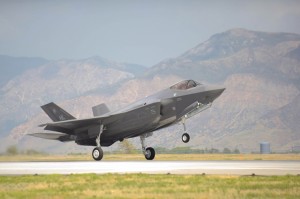The Air Force’s New Lightning
Tuesday, August 23rd, 2016August 23, 2016
On August 2, the United States Air Force declared its new F-35 Lightning II fighter planes ready for combat. The F-35 (F is the Air Force designation for a fighter plane) is a “fifth generation” fighter, combining advanced stealth technology with heavy firepower, long range, high speed, and remarkable agility. Stealth technology allows an aircraft to evade radar detection. Eventually, variants of the F-35 will be the core fighters throughout the Air Force, Navy, and Marine Corps. Such Allied nations as Australia, Italy, and the United Kingdom will also fly F-35 squadrons. The Lockheed Martin Corporation, headquartered in Bethesda, Maryland, designed the F-35 Lightning II.

A Lockheed Martin F-35 Lightning II lands at Hill Air Force Base, Utah, on Sept. 2, 2015. Credit: Todd Cromar, U.S. Air Force
The F-35 development program began in 2001. The first production F-35 flew in 2006 and variants were tested over the next several years. The program took longer than expected, and it cost more too (the average price tag is $178 million per aircraft). The first F-35 military training squadrons were activated in 2013.
A Pratt & Whitney turbofan jet engine allows the F-35 to fly at Mach 1.6 (roughly 1.6 times the speed of sound), or about 1,200 miles per hour (1,930 kilometers per hour). The aircraft can reach a maximum altitude of more than 50,000 feet (15,000 meters). The plane’s range is 1,350 miles (2,170 kilometers) with internal fuel, or unlimited with aerial refueling (receiving fuel from another plane or a drone while in flight). The plane carries one pilot with a helmet-mounted display system showing all intelligence and targeting information on the pilot’s visor. The F-35 has “internal and external” armaments, including rapid-fire cannons, missiles, and bombs.
F-35 variants include fighters modified for use on aircraft carriers and aircraft with short takeoff /vertical landing (STOVL) capability. STOVL variants are equipped with special propulsion systems and swiveling engines, allowing the plane to fly straight up and down and stop and turn in midair. Over the next several years, the Lightning II will replace older fighters such as the F-16 Falcon, F/A-18 Hornet, A-10 Warthog, and AV-8 Harrier. Lockheed’s first “Lightning,” the P-38, was one of the most famous fighters of World War II.


